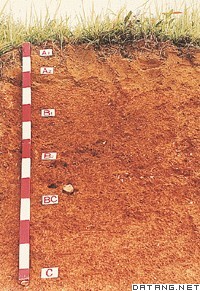1) red soil texture


红壤质地
2) Red soil quality


红壤质量
3) upland red soil


红壤旱地
1.
Characteristic of nitrogen wet deposition and its contribution to nitrogen balance of the graze-vegetable rotation ecosystem in upland red soil;
红壤旱地湿沉降氮特征及其对马唐-冬萝卜连作系统氮素平衡的贡献
2.
Evaluation on comprehensive benefits of multiple cropping systems on upland red soil;


红壤旱地多熟种植系统的综合效益评价
3.
The effect of different manure on soil microorganisms and soil enzyme activities in an upland red soil was studied through a four-year field planting experiment.
结果表明:1)2种有机肥均能提高红壤旱地有机质和速效氮、磷、钾的含量,而腐熟猪粪配施化肥处理的速效氮、磷、钾含量均显著高于纯施猪粪处理和纯施秸秆处理(p<0。
4) red soil region


红壤地区
1.
Effect of Eulaliopsis binata plantation on soil quality in red soil region of southern China;
南方红壤地区种植龙须草对土壤质量的影响
2.
Paddy soil quality assessment under rice-ryegrass rotation system in red soil region of mid-subtropics;
中亚热带红壤地区稻-稻-草轮作系统稻田土壤质量评价
3.
The resource of grassland in southern red soil region is very abundant, having the vast development prospect.
我国南方红壤地区草地资源十分丰富,具有广阔的开发利用前景,但由于红壤自身特性和不合理的施肥管理制度,致使该地区草地生态系统严重退化,草地生产力低。
5) red-soil slope land


红壤坡地
1.
Benefits of soil and water conservation in red-soil slope land by adoption of different coverage measures;
红壤坡地不同覆盖措施的水土保持效益分析
2.
Process of nutrient loss of red-soil slope land under comprehensive soil and water conservation measures;
水土保持综合措施对红壤坡地养分流失作用过程研究
3.
Based on the observed data of different types of terraces on red-soil slope land in Soil Conservation Ecological Science & Technology Demonstration Park of Jiangxi Province,an analysis was made on the effect of water and soil conservation and orange growth in different types of terraces.
应用江西省水土保持生态科技园红壤坡地不同类型梯田小区的观测资料,对不同类型梯田的水土保持效应和柑橘生长情况进行分析。
6) upland red soil


山地红壤
1.
In a study reported in this paper, no-cultivation meadow (A) was used as control sample to study the effect of rotation systems on soil fertility of upland red soil in Yunan plateau.
以未开垦利用的荒草地(A)为对照,研究不同轮作方式对高原山地红壤肥力的影响。
2.
Study on the different characters of upland red soil fertility under steady cultivation systems by different utilizations.
研究了稳定耕作系统下的不同利用方式的高原山地红壤肥力变化特征。
补充资料:红壤
| 红壤 red earth 发育于热带和亚热带雨林、季雨林或常绿阔叶林植被下的土壤。主要特征是缺乏碱金属和碱土金属而富含铁、铝氧化物,呈酸性红色。主要分布于非洲、亚洲、大洋洲及南北美洲的低纬度地区。大致以南北纬30°为限。在中国,北起长江沿岸,南抵南海诸岛,东自台湾省,西至云贵高原及横断山脉为主要分布区域。红壤的形成是在高温多雨、植被茂密的生物、气候条件下,土壤中富铝化和生物富集相互作用的结果。根据成土条件的变化和富铝化作用的强度,中国境内红壤可分为砖红壤、砖红壤性红壤、红壤、黄壤4个亚类。前2类多见于热带和南亚热带,土体中碱金属及碱土金属含量均低,pH4.5~5.0,适宜种植热带和亚热带作物及水稻。第3类多见于亚热带低山丘陵地带,土壤pH5.0左右,富铝化程度较前2类弱,适宜种植亚热带经济作物和水稻、玉米等。为更好地利用红壤,须对其淋溶作用强、矿质养分少、酸性大、易产生铝锰毒害、保肥性能差和质地粘重或砂粒过多等不良性状进行改良。具体措施是:增施氮、磷、钾等矿质肥料,氮肥宜用粒状或球状深施,磷肥宜与有机肥混合制成颗粒肥施用;施用石灰降低土壤酸性;合理耕作;选种适当的作物、林木,种植绿肥是改良红壤的关键措施;旱地改水田,减少水土流失并有利于有机质积累,提高土壤生产力;保护植被,防治侵蚀,凡坡度大于25°的陡坡应以种树种草为主,小于25°的坡地根据陡缓状况修建宽窄不等的等高梯地或梯田种植。
|
说明:补充资料仅用于学习参考,请勿用于其它任何用途。
参考词条
